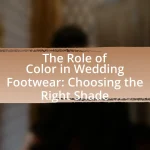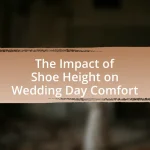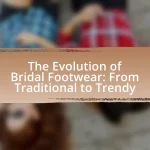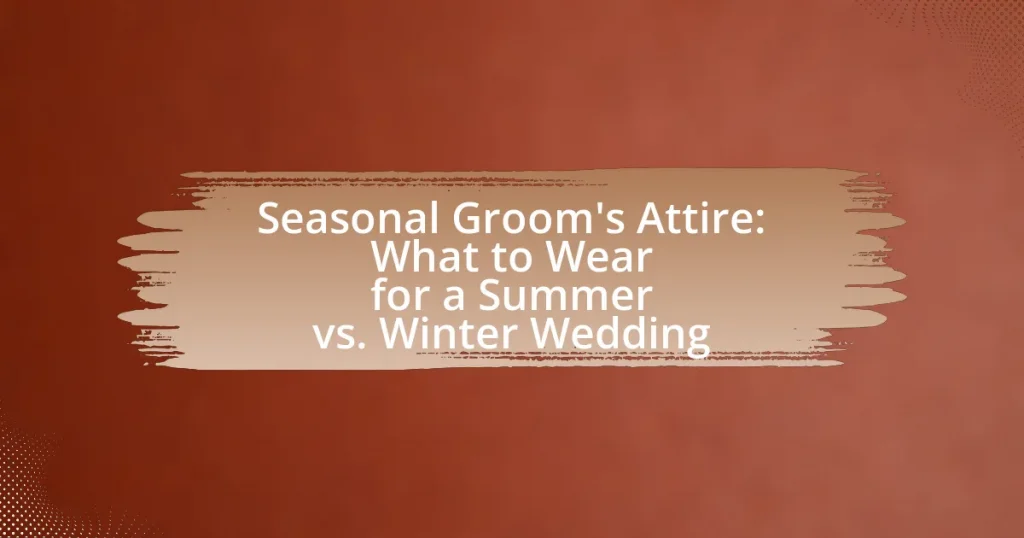Seasonal groom’s attire for weddings is defined by the clothing choices made by grooms based on the wedding season. For summer weddings, grooms typically select lightweight fabrics such as linen or cotton in lighter colors, while winter weddings call for heavier materials like wool or velvet in darker shades. The article explores the importance of considering the season when choosing attire, detailing how climate influences fabric choices, color palettes, and layering options. It also highlights popular styles and accessories for both summer and winter weddings, providing practical tips for grooms to ensure comfort and style throughout their special day.
What is Seasonal Groom’s Attire for Weddings?
Seasonal groom’s attire for weddings refers to the clothing choices that grooms make based on the season in which the wedding takes place. For summer weddings, grooms typically opt for lighter fabrics such as linen or cotton, often in lighter colors like pastels or neutrals to reflect the warm weather. In contrast, winter weddings usually see grooms wearing heavier materials like wool or tweed, often in darker shades such as navy, charcoal, or deep green, which provide warmth and a more formal appearance suitable for the season. This seasonal differentiation in attire is supported by fashion guidelines that emphasize comfort and appropriateness for the climate, ensuring that the groom looks stylish while also being practical for the weather conditions.
Why is it important to consider the season when choosing groom’s attire?
Considering the season when choosing groom’s attire is crucial because it directly impacts comfort, style, and appropriateness for the wedding environment. For instance, summer weddings typically call for lighter fabrics like linen or cotton to ensure breathability and comfort in warmer temperatures, while winter weddings often necessitate heavier materials such as wool or velvet to provide warmth. Additionally, seasonal colors and styles can enhance the overall aesthetic of the wedding; for example, earthy tones are popular in fall, while bright colors are favored in spring. This alignment with seasonal trends not only ensures the groom looks appropriate but also contributes to the cohesive theme of the wedding.
How does the season influence fabric choices for groom’s attire?
The season significantly influences fabric choices for groom’s attire by dictating the weight, breathability, and insulation properties of the materials selected. In summer, lightweight fabrics such as linen and cotton are preferred due to their breathability and ability to keep the groom cool in warm temperatures. Conversely, in winter, heavier fabrics like wool and tweed are favored for their warmth and insulation, ensuring comfort in colder conditions. This seasonal differentiation is supported by the fact that weddings often occur outdoors during summer, where lighter fabrics enhance comfort, while winter weddings necessitate materials that provide adequate warmth.
What role does climate play in selecting the right outfit for the groom?
Climate significantly influences the selection of the groom’s outfit by dictating the fabric, style, and layering choices. In warmer climates, breathable materials like linen or cotton are preferred to ensure comfort, while lighter colors can reflect heat. Conversely, in colder climates, heavier fabrics such as wool or tweed are suitable, often requiring additional layers like vests or jackets to provide warmth. This adaptation to climate not only enhances comfort but also aligns with traditional wedding attire practices, ensuring that the groom remains stylish and appropriate for the season.
What are the key differences between summer and winter groom’s attire?
The key differences between summer and winter groom’s attire lie primarily in fabric choice, color palette, and layering. Summer groom’s attire typically features lightweight fabrics such as linen or cotton to ensure breathability and comfort in warmer temperatures, while winter attire often utilizes heavier materials like wool or tweed for insulation against cold weather.
In terms of color, summer weddings often embrace lighter shades such as pastels or bright colors, reflecting the season’s vibrancy, whereas winter weddings tend to favor darker, richer hues like deep blues, burgundies, or greens, which complement the season’s aesthetic. Additionally, winter groom’s attire frequently includes layers such as vests or overcoats to provide warmth, while summer attire is generally more streamlined and less layered to accommodate heat.
What styles are most popular for summer weddings?
The most popular styles for summer weddings include light and breathable fabrics, such as linen and cotton, which help keep guests comfortable in warm weather. Additionally, pastel colors and floral patterns are favored for their vibrant and fresh aesthetic, aligning with the season’s natural beauty. According to a survey by The Knot, 40% of couples choose outdoor venues for summer weddings, further emphasizing the need for attire that suits a relaxed and airy atmosphere.
How do winter weddings affect color and fabric choices?
Winter weddings typically influence color and fabric choices by favoring richer, darker hues and heavier materials. The cold weather encourages the use of colors like deep reds, emerald greens, navy blues, and metallics, which evoke a warm and festive atmosphere. Fabrics such as velvet, wool, and heavier silks are preferred for their warmth and luxurious appearance, contrasting with lighter fabrics used in summer weddings. This shift in choices aligns with the seasonal aesthetic, as winter weddings often incorporate elements like cozy textures and opulent colors to create a comfortable and elegant ambiance.
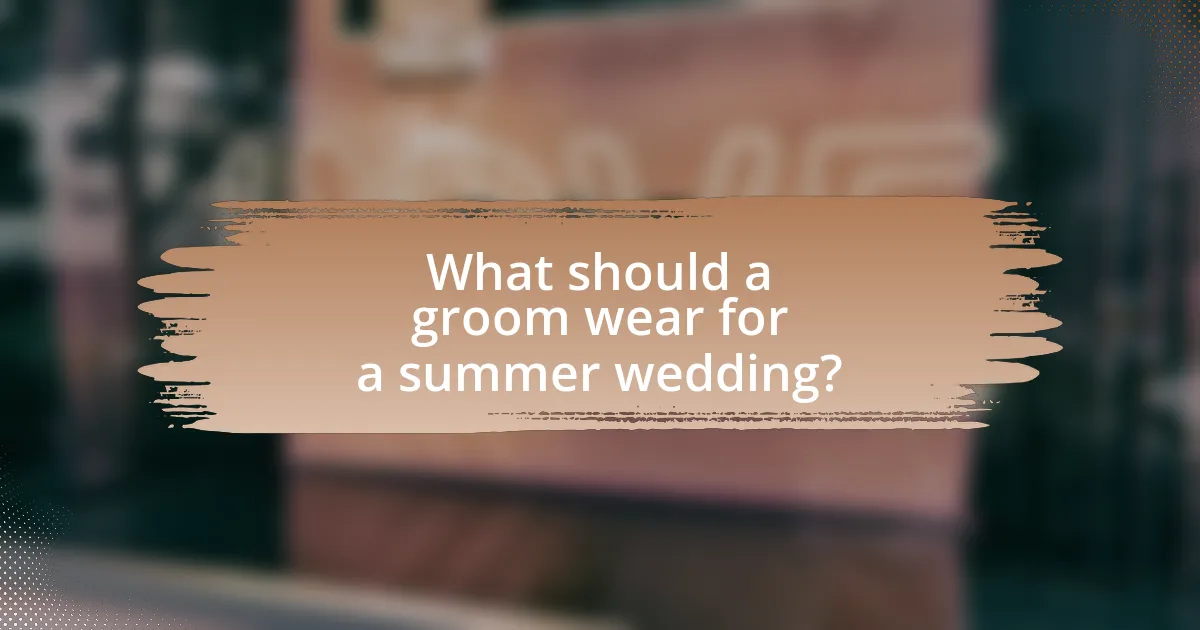
What should a groom wear for a summer wedding?
A groom should wear lightweight, breathable fabrics for a summer wedding, such as linen or cotton suits. These materials help keep the groom cool in warm weather while maintaining a polished appearance. Light colors like beige, light gray, or pastel shades are also recommended, as they reflect sunlight and contribute to a fresh, summery look. Additionally, a groom may opt for a short-sleeved shirt or a waistcoat to enhance comfort without sacrificing style.
What are the best fabric options for summer groom’s attire?
The best fabric options for summer groom’s attire include lightweight materials such as linen, cotton, and seersucker. Linen is highly breathable and moisture-wicking, making it ideal for hot weather, while cotton offers comfort and versatility. Seersucker, with its puckered texture, allows air circulation and helps keep the body cool. These fabrics are commonly chosen for their ability to provide comfort and style during summer weddings, ensuring that the groom remains comfortable throughout the event.
Why are lightweight fabrics preferred for summer weddings?
Lightweight fabrics are preferred for summer weddings because they provide comfort and breathability in warm weather. These materials, such as linen, cotton, and chiffon, allow air circulation, helping to regulate body temperature and prevent overheating during outdoor ceremonies or receptions. Additionally, lightweight fabrics tend to drape elegantly, enhancing the overall aesthetic of summer wedding attire while ensuring that the wearer feels at ease throughout the event.
How do breathable materials enhance comfort during summer ceremonies?
Breathable materials enhance comfort during summer ceremonies by allowing air circulation and moisture wicking, which helps regulate body temperature. Fabrics such as linen, cotton, and lightweight blends facilitate evaporation of sweat, reducing the discomfort associated with heat. Studies indicate that breathable textiles can lower skin temperature by up to 5 degrees Celsius compared to non-breathable options, making them ideal for warm weather events. This temperature regulation is crucial for maintaining comfort during extended periods of outdoor activities, such as weddings.
What styles and colors are trending for summer weddings?
Trending styles for summer weddings include light and breathable fabrics such as linen and cotton, often in tailored suits or casual ensembles. Popular colors for summer weddings are soft pastels like blush pink, lavender, and mint green, as well as vibrant hues like coral and turquoise. These choices reflect the season’s warmth and are supported by wedding industry reports indicating a rise in these color palettes for 2023, aligning with the desire for fresh, airy aesthetics in summer celebrations.
What are the most popular color palettes for summer groom’s attire?
The most popular color palettes for summer groom’s attire include light and airy shades such as pastels, soft blues, light grays, and beige. These colors are favored for their ability to reflect the warmth of summer while maintaining a fresh and elegant appearance. Pastel colors like mint green, blush pink, and lavender are particularly trendy, as they complement outdoor settings and floral arrangements commonly associated with summer weddings. Additionally, light gray suits paired with white or light-colored shirts offer a sophisticated yet relaxed look, ideal for warm weather.
How can accessories complement a summer wedding outfit?
Accessories can enhance a summer wedding outfit by adding visual interest and personal style. For instance, lightweight fabrics like linen or cotton can be paired with accessories such as a straw hat or sunglasses to provide both functionality and flair, while a colorful tie or pocket square can introduce a pop of color that complements the overall look. Additionally, breathable materials in accessories help maintain comfort in warm weather, ensuring that the groom remains stylish and at ease throughout the event.
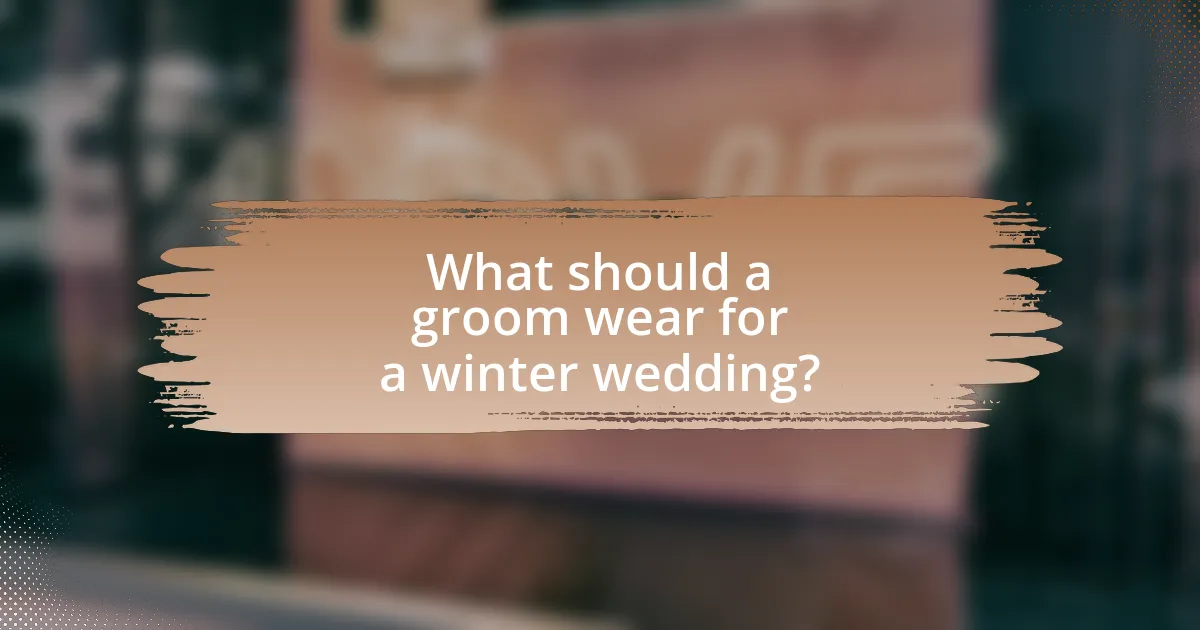
What should a groom wear for a winter wedding?
A groom should wear a tailored suit or tuxedo made from heavier fabrics like wool or velvet for a winter wedding. These materials provide warmth and a sophisticated appearance suitable for colder temperatures. Additionally, incorporating layers such as a stylish overcoat or a waistcoat can enhance both comfort and style. Accessories like a warm scarf or gloves can also be included to maintain warmth while complementing the overall look.
What are the best fabric options for winter groom’s attire?
The best fabric options for winter groom’s attire include wool, tweed, and velvet. Wool is favored for its warmth and durability, making it ideal for colder temperatures. Tweed offers a classic, textured look that provides insulation, while velvet adds a luxurious touch and retains heat effectively. These fabrics not only ensure comfort but also maintain a sophisticated appearance suitable for winter weddings.
How do heavier fabrics provide warmth for winter weddings?
Heavier fabrics provide warmth for winter weddings by offering better insulation and thermal retention compared to lighter materials. These fabrics, such as wool, velvet, and heavy silk, trap air within their fibers, creating a barrier that retains body heat. For instance, wool has natural insulating properties due to its crimped structure, which helps to keep warmth close to the body. Additionally, the density of heavier fabrics reduces the amount of cold air that can penetrate, making them ideal for colder temperatures typically experienced during winter weddings.
What are the advantages of layering in winter groom’s outfits?
Layering in winter groom’s outfits provides enhanced warmth, versatility, and style. The primary advantage is that it allows grooms to adjust their clothing according to varying indoor and outdoor temperatures, ensuring comfort throughout the event. For instance, a groom can wear a tailored suit with a vest and an overcoat, which can be removed indoors to maintain a polished look while staying warm outside. Additionally, layering adds depth and texture to the outfit, enabling grooms to incorporate different fabrics and colors, which can elevate their overall appearance. This approach not only meets practical needs but also aligns with contemporary fashion trends, making it a smart choice for winter weddings.
What styles and colors are trending for winter weddings?
Trending styles for winter weddings include elegant and formal attire, with a focus on rich fabrics like velvet and heavier materials. Popular colors for winter weddings are deep jewel tones such as emerald green, burgundy, navy blue, and classic white, often complemented by metallic accents like gold and silver. These choices reflect the seasonal ambiance and are supported by wedding industry reports indicating a rise in the popularity of these colors and styles during winter months.
What color schemes are popular for winter groom’s attire?
Popular color schemes for winter groom’s attire include deep jewel tones such as emerald green, navy blue, and burgundy, as well as classic neutrals like charcoal gray and black. These colors are favored for their ability to complement the winter season’s aesthetic, providing a rich and elegant look. Jewel tones are particularly sought after because they evoke warmth and sophistication, while neutrals offer a timeless and versatile option that pairs well with various wedding themes.
How can winter accessories enhance the overall look?
Winter accessories can enhance the overall look by adding layers of style and sophistication to winter attire. Accessories such as scarves, hats, gloves, and stylish outerwear not only provide warmth but also serve as focal points that can elevate an outfit. For instance, a well-chosen scarf can introduce color and texture, while a tailored coat can create a polished silhouette. According to fashion experts, incorporating these elements can transform a basic outfit into a cohesive and fashionable ensemble, making the wearer stand out in winter settings.
How can grooms transition their attire from summer to winter weddings?
Grooms can transition their attire from summer to winter weddings by opting for heavier fabrics, layering, and incorporating warmer accessories. In summer, lightweight materials like linen or cotton are common, while winter attire should include wool, tweed, or heavier blends to provide insulation. Layering options such as vests or tailored jackets can add warmth and style, while accessories like scarves, gloves, and hats can enhance the winter look. This approach ensures that grooms remain comfortable and stylish, adapting their outfits to the seasonal climate effectively.
What are some practical tips for choosing seasonal groom’s attire?
To choose seasonal groom’s attire effectively, consider the climate and venue of the wedding. For summer weddings, opt for lightweight fabrics like linen or cotton to ensure comfort in heat, while lighter colors can reflect sunlight. In contrast, for winter weddings, select heavier materials such as wool or velvet to provide warmth, and darker shades can create a more formal appearance. Additionally, layering options like vests or jackets can enhance style and adaptability to changing temperatures. These choices align with common practices in wedding attire, ensuring both comfort and aesthetic appeal for the groom.

